In today’s fast-paced world, innovative processes and systems are constantly evolving to improve efficiency across various industries. One such concept is decking. Although the term might not be widely known yet, decking is becoming increasingly important in fields where optimization and productivity are crucial. But what exactly is decking, and why is it gaining attention?
What is Deckering?
Deckering refers to a specialized process or technique used to organize, layer, or structure different elements for improved functionality. It often involves optimizing resources, arranging materials, or strategically placing components to achieve better performance in an operation or system.
This concept is applied in diverse fields such as logistics, construction, and technology. In simpler terms, deckering helps arrange things in a way that makes them easier to use, access, or manage, ensuring smoother workflows and outcomes.
History and Evolution of Decking
The idea of arranging or layering materials for better efficiency isn’t new, but the concept of decking, as we understand it today, has evolved with technological advancements. Early uses of decking can be traced back to industries like construction, where materials needed to be stacked or layered effectively for building projects.
As technology developed, the need to “deck” digital components, physical materials, or workflows became more prominent, leading to the modern forms of decking we see today. The term now applies to more than just physical materials – it encompasses digital and operational strategies as well.
Different Types of Deckering
While deckering is a broad concept, it can be categorized based on its application. Some common types include:
- Physical Deckering: In industries like construction, decking involves the physical arrangement of materials such as scaffolding or flooring to optimize space and workflow.
- Digital Deckering: In technology, decking refers to structuring data or software components to ensure smooth operation, such as layering software modules or arranging digital resources in a system.
- Logistics Deckering: In logistics and supply chain management, decking can involve arranging shipments or cargo in a way that maximizes space and minimizes transportation costs.
Each of these categories highlights the versatility of decking and its applicability in various fields.
Benefits of Decking
Deckering offers several benefits that can lead to improved productivity and resource optimization, including:
- Efficiency Gains: Proper decking ensures that materials or components are organized in the best possible manner, reducing the time and effort required to access or utilize them.
- Cost Savings: By optimizing space, whether in a physical warehouse or a digital storage system, deckering can lead to significant cost reductions.
- Environmental Impact: In some cases, decking helps reduce waste by maximizing resource use, which can lead to more sustainable practices.
These advantages make decking an essential tool for businesses and industries looking to improve operations and reduce overhead.
How to Implement Decking: Best Practices
For those looking to implement deckering in their business or projects, here are a few best practices:
- Assess Your Needs: Understand the scope of your project and determine where decking can make the biggest impact.
- Use the Right Tools: Depending on the type of deckering you’re implementing, use tools that can help you organize, layer, or structure resources effectively. This could range from physical tools in construction to software solutions in digital industries.
- Optimize for Performance: Regularly review your decking setup to ensure it continues to optimize efficiency as your project or business grows.
Common Challenges in Deckering and How to Overcome Them
Like any process, deckering comes with its own set of challenges. Some of the common issues include:
- Overcomplication: In some cases, deckering can become too complex, leading to inefficiencies rather than improvements. To avoid this, keep deckering strategies simple and focused.
- Implementation Costs: The initial setup for decking, especially in larger projects, may require upfront costs. However, the long-term savings usually outweigh these initial expenses.
- Training Requirements: Deckering processes may require training for teams to fully understand and utilize the system. Address this by offering thorough training programs and clear documentation.
Case Studies: Successful Deckering Projects
To better understand how deckering can be implemented successfully, let’s look at a few case studies:
- Construction Deckering: A construction company used decking to organize its scaffolding and building materials, resulting in faster project completion times and reduced material waste.
- Digital Deckering: A software development team structured its programming modules using decking principles, leading to smoother development cycles and more efficient code management.
These examples showcase how decking can lead to tangible improvements across different industries.
Future Trends in Decking
As industries continue to evolve, so will the concept of deckering. Some of the emerging trends include:
- Automation in Deckering: The use of AI and machine learning to automate decking processes, especially in logistics and digital environments, is on the rise.
- Sustainability Initiatives: Deckering strategies that focus on sustainability, such as reducing resource consumption or minimizing waste, are becoming more popular as environmental concerns grow.
- Deckering in Digital Transformation: As businesses move towards digital transformation, decking will play a key role in organizing and optimizing digital assets for more efficient operations.
10. Conclusion:
Decking is a versatile concept that can be applied across multiple industries to improve efficiency, reduce costs, and promote sustainability. Whether you’re working in construction, technology, or logistics, implementing deckering strategies can help optimize your processes and lead to better outcomes. As industries continue to grow and evolve, deckering will become an increasingly valuable tool for those looking to stay ahead of the competition. Now is the time to explore how decking can benefit your business or project, ensuring that you remain efficient and effective in a fast-paced world. This article presents decking in a clear, straightforward manner, offering value to readers while incorporating the keyword naturally. Let me know if you’d like any adjustments!




